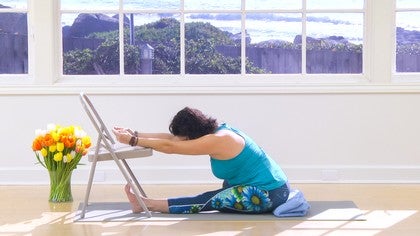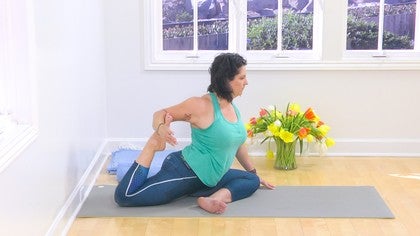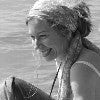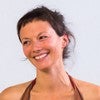Description
About This Video
Transcript
Read Full Transcript
Namaste, welcome to restoration. So today's class, it's a very simple sequence, but it has a great and profound effect on your nervous system. It allows you to deeply, deeply rest to go into the rest and restore aspect of your nervous system. We have two. We have the fight or flight, which you've probably heard of.
It's when your adrenals kick in, everything's ready, and you're either fighting or you're running for your life, right? And most of us, in the stress of the day, have a fair amount of that going on. And it does deepen, it moves into the body. So the purpose of this class is to route that out, to take the whole system back to a state of restoration. Now it's interesting to know that animals will rest up to 40 times a day.
Isn't that incredible? And that's just not just domestic animals. That is wild animals will stop and rest and restore themselves. I don't know about you, but I don't do that. I tried it once.
I got to about 17 or 18, and then that was about it. So coming to this practice at the end of your day, even sometimes at the beginning of your day, allows your system to sort of reboot and get you to a state of really deep healing in the body. So we're going to start out with the rejuvenator, and you may have already experienced that with me. So follow along. You won't need a blanket.
You just put that off to the side. You're going to lie on your back, and once you're on your back, extend the arms and the legs away from one another, just feel that nice, long spine. Remember you're not going to ever work at more than maybe 60%, 70% of your effort as we're restoring. We don't want to wake the body, but we don't want to shake the body. Just reaching here.
This is the inhalation position. As you exhale, your next exhalation, just draw the legs into your chest, and you don't have to over-squeeze. Again, this is not dramatic. This is really sweet. Here comes the inhalation.
I'm going to straighten my legs. You can straighten them together or separated like I just did, and the exhalation. Let's do three more on your own, inhaling nice and long, exhaling. Because both sides of the body are doing the same thing, you already start to slip into that quietness of the parasympathetic nervous system. We're going to move to a modified version of that.
On the exhalation, the hold is the same, but the next inhalation, the legs go up and the arms overhead, exhaling, and inhaling. Now it's interesting, if this feels a whole lot easier, then I'd rather you just do this the next time you run through the sequence with yourself. Notice your eyes. Sometimes we'll be working to relax the body, and our eyes are popping out of our head. Make sure your eyes are relaxed.
You can consciously do that. It doesn't take anything more than deciding that your eyes need to relax. Let's let the feet come to the floor now, put your hands on your belly for a moment. If you're still trying to sort of figure out what your eyes are doing, see if you can activate your peripheral vision. That means that you relax the vision, you're not focusing on anything, and yet your eyes can sort of see everything, but there's no focus.
Now when we do that with our eyes, oh my, the system really starts to release some of that deep tension. All right, we're going to roll to our side now, and rolling to the side is important. I'm going to show you a little something. If I get up from my yoga posture like this, it's sort of like, is there a lion coming? Like, right?
So you're all relaxed, you've done all this great stuff, and you're like, don't do that. Don't do that. I want you to come up like this. I want you to come up, rolling to your side, just like you would if you were getting up in the morning, and you're letting yourself stay quiet, letting yourself stay quiet, and bringing yourself up, and bringing yourself around to sitting. This is much easier on the system.
You're going to want to do that, trust me. You can try it both ways if you want to, but if you roll to your side enough times, maybe ten times, if you're not used to doing it, you're going to see a great benefit doing it that way. All right, so now we're going to do one of my favorite postures. This posture is called pigeon pose. You might need a blanket for this.
It's going to slide your right leg forward and extend the other leg back. Now if you're hovering, remember, if you're hovering on the shin, this kind of creates tension in the pelvis, it's going to create tension in the knee. So it's really better for you to get a blanket and place the blanket or a block under there so that you can really rest the hip. Don't skip this part. This is super important, because if you're hovering and there's tension, then the unwinding is really not going to happen in the way that we're working towards.
So one of the things that's going to happen in the pigeon pose that's so brilliant is I'm going to open the piriformis muscle, and I'm going to open the front psoas muscle. And these two muscles are, along with the hamstrings, are prime movers. They move us forward. When we relax these muscles, we start to deeply relax on the inside. And because of stress and tension during the day, maybe not moving around enough or maybe moving around too much for whatever's going on, those muscles sort of stay tense and toned instead of really relaxing.
So this is going to help them really relax. So I'm folding down to my elbows, just like this. You may already feel something going on in your rump, in the bent leg rump. I'd like for you to consider pressing the legs down, sort of feeling like you're pulling them towards one another. I call it scissoring the legs.
In this scissoring aspect of the legs, it affects the piriformis more deeply. Taking a breath. You might see if you can go a little lower, but I don't want the head to dangle. Don't want your head hanging out in space. So you can rest it on your hands, you could even stack your fist if you like.
Just giving a few more breaths to that area. May already be feeling a little bit better in there. I'm going to take the hands now to support, curl my toes under, lift the back leg, firm the belly, and slide back to hands and knees. This is where it gets really fun. I'm going to take my other leg back a little bit further so that the foot's up the wall.
If you have something supporting your hip, go ahead and bring it back towards you. And then I'm going to take the front leg back into pigeon. This might look a little complicated, but just give yourself a minute, figure it out, negotiate it. We're going to end up back on the elbows. You can see that my toes are curled under.
That's kind of a nice position for the toes. Some of you may already feel like something's happening in the front body. That's the psoas stretching. You can go ahead and rest a little deeper, a few breaths here. Probably the right rump is feeling a little bit better.
And then up we come. All right, now we're going to go a little deeper in the psoas muscles. So I'm going to reach back and grab my leg and encourage it to move closer to my body. Now when I do that, you can see I'm having to kind of turn my body, so I'm going to ask the body to turn a little more forward. Then my tailbone, I'm going to curl my tailbone under.
And as I curl my tailbone under, I'm going to lift up into the chest. You might be going, oh. Just go ahead and feel the lengthening of the front part of the body. Remember, you should be working at about 60% to 70% sensation and effort, and that keeps it right in that restoring aspect of the nervous system. We're going to come down now, release the leg.
The toes can curl into the wall again. I'm going to press my hands. I'm going to pull my right leg back and my back leg forward, and then just step your hands out for a little downward dog. In your downward dog, the eyes are still quiet. The neck is relaxed.
If you're not sure if your neck is relaxed, tuck your chin for a couple of breaths. Hold it there, and then release the chin away from the chest, and that will probably put your head right where it belongs to be really relaxing. Coming on down. Let's do the second side. I'm going to bring the opposite leg forward into pigeon.
The back leg's going to straighten out, just like that. I come on down to my elbows again. If you need that support under this hip, of course, you're going to use it. You're going to put it under there because you don't want to dangle in that shin. Then again, just notice your eyes, and you're in a whole other piriformis.
If it's feeling a little tense in there, relax the eyes. Don't harden the eyes. It's sending a different message to the nervous system than we want, so relax the eyes. Scissor the legs, just to the point that the sensation feels right for you. Remember, the head doesn't dangle, it's supported.
Taking that breath. Okay, and then up we come. We're going to do the same thing we did before. Toes curl under. I'm going to lift the leg, press myself back to hands and knees, and then I'm going to take that straight leg a little closer to the wall, and then slide back into my pigeon.
Now, you'll create that support again under the hip if you need it. Probably by now some of you are starting to yawn. The yawning reflex is actually the psoas starting to open, this front muscle starting to open. When it contracts, it helps you to bring your leg forward, and then once that starts to release, we get drowsy, and that's a great thing. This is my little sequence I like to do before I go to sleep at night, it's really helpful.
Coming on down. Feeling what's happening in the hip, feeling what's happening in the back leg. Now let's go in, hands are coming back. I want the tailbone to turn down, and the body to sit up. You might already be feeling a lot of sensation here.
If you're not, you can reach back and grab your foot and just encourage the heel to move closer to the body. As the tailbone moves down and the chest moves up, the psoas begins to lengthen and lengthen and lengthen. Nice breath, notice your eyes. If you're starting to feel hardness in the eyes, you might be going a little too deep into the posture. I'm going to unwind that leg.
My toes are curled into the wall, I'm going to use that, I'm going to push into the wall a little bit to slide forward and then drag that front leg back and move right into downward facing dog. Notice your eyes again, but also notice what's going on with the neck. The yawning may continue, congratulations if that's happening. And on the way down. That's working both sides, that's why pigeon is so brilliant, but I want to show you a way to get into the piriformis muscle with a little bit more intelligence.
You're going to lie on your back, close to the wall, you'll make a 90 degree angle with your leg. You see the square? You make a square right there, and then just cross your other leg over. Now the interesting thing about this posture is we're not going to touch this bent leg, the one that you just crossed. You're going to use your muscle and the intelligence of the muscle to press the knee away from you.
Flex the foot, this is dorsiflexion, and then you're going to draw that foot off the wall, interlace behind the thigh. Now I have a great desire to press with my elbow, this leg, don't do that. Just pull. Now look, this foot's flexing as well. It could be that while you're here, you're feeling like, oh I feel it in my piriformis, oh I don't, oh I do, oh I don't.
That's because the nature of this leg and the knee. You're going to use your muscles to push that knee away, but it's just the muscles of your extender muscles of your leg. So you're using only the muscles of the hip and part of the leg to create that. Don't push on it yourself. Some of you might like to straighten this leg and start to work the hamstring just a little bit, but don't straighten the leg if this foot is directly on your knee.
That can be a little uncomfortable to the knee joint. That foot comes back down. Back to the floor for a moment. Notice your eyes. See if you can feel a difference between the two sides.
Back up we go. Both feet making that square, opposite leg crosses. I'm going to create the dorsiflexion with the foot. Going to create the release of the knee through the workings of the hip, not using my arms, and then I'll interlace behind and draw that wall leg towards the body. Now, if you can keep the feet in this flexion, you're going to help to accelerate what's opening in the piriformis muscle.
It's also affecting a little bit gluteus medius and some of the deeper muscles of the glutes, like the underside that's right around the piriformis. Again, some of you might like to straighten your leg, but only if the knee's not being compromised, so this shouldn't be bothering your knees. Noticing your eyes. Let them be relaxed. And slowly bend, place the foot back on the wall, release the lifted leg down, rest again, put the hands on the belly, notice your eyes, and so allow yourself to feel with your senses how the pelvis feels right now.
Usually there's sort of a feeling of like a current, like it just got washed. You're going to practice rolling to the side again, so I'm going to roll, keep turning towards the floor, and bring myself up nice and sweetly so that really the head is the last thing that comes up. So let's bring ourselves now to downward facing dog. You'll have your feet pointed towards the wall. Let's take a nice stretch.
For a lot of us, this feels really good to the hamstrings, and the hamstrings are our last frontier to bring us to the parasympathetic and to a state of being more relaxed. Come downward dog, we'll take a little movement forward, just take the hands a little closer. The heels may or may not come down to the ground, don't worry about that. Walk the hands a little closer. Now if your heels are right up against the wall, I want you to step them off the wall just a little bit.
Don't be right up against the wall. Hands a little closer, it's okay if the heels aren't making contact, don't worry about that. Let's see if you can come all the way up into Uttanasana, and if it feels like the wall is pushing you, then your feet are too close, so just step them away. You might even have them at the perfect place where you can rest the buttocks on the wall, interlace the elbows, and let the spine get long, but also let the tailbone slide up the wall. So we're asking the hamstrings to lengthen.
Lengthen the knees, walk back out to your dog, back down to the knees, and back around for a final rejuvenator. One of the things that the nervous system really likes is these postures where both sides of the body are doing the same thing, just like it was in those two postures in Downward Dog and folding forward in that way. It's the same for the rejuvenator, so as you exhale, draw the legs into your chest. We're going to take the legs straight up this time, it's a little easier on the body, and we're moving towards our Shavasana. Exhaling, inhaling, legs are going straight up, arms overhead.
Three more on your own. If you get confused about when to breathe, just notice that when the arms are overhead and the legs are up, there's plenty of room for the lungs to expand. So that's your inhalation. And when you're drawing the legs into the chest, it's not as much room, and you're helping your lungs to release the air. Take the feet now to the floor, practicing rolling again, right?
Don't jump up like a lion's about to eat you, roll it this way. We're going to take a couple of our blankets now and make a blanket bolster. This is one of my favorite things to do with my blanket, so I'll show you. So it's just a regular Mexican blanket. You'll open it up to the forefold like this, lay that out, make your second one and do the exact same thing.
So I'm just letting the fringes line up. Two blankets on top of each other. You can really use anything, right? You might have different kinds of blankets, it's fine. Use whatever you have, but you want your roll to look something, something like this.
See that? Okay. That goes right there, because we're going to be putting the arches of our feet in there. It feels so super good. Now your other blanket, you'll just roll into a tube, just like this.
That's going to be for your knees. To come into it, it's kind of sweet actually. We're going to kind of lock ourselves into the wall, and in order to do that, you just kind of follow along. So get in this position, all right? I'm just getting a little closer, and I lie on my back, and I'm going to slowly start to straighten my legs, and the skin of my body is actually sort of being held by the sticky mat.
So it's pulling the skin of my body down as I straighten my legs, and you may not fully come to straight legs, of course you won't because of the knee rest there, but it may even feel lighter than that, and that's fine. The skin of my back body, my shoulder blades, and my sacrum are all being tugged in the direction of the wall, and I feel sort of magnetically stuck to the floor. It's fantastic. It's probably one of the most relaxing Shavasana positions that I use. So once you're in there and you kind of feel that sort of feeling of being held by gravity, allow your eyes to close.
You're letting the bones get heavy, and periodically you may have to wiggle a little bit, because as the body settles in it requires these minute refinements, so don't be afraid to do that. You're breathing in and out through your nose, you're feeling the eyes fall back into the head, the jaw is relaxed, the mind is letting go of the practice. It's no more holding, it's only being. Being dropping deeply, growing more and more quiet in your Shavasana. I'm going to bring myself up, but you stay where you are.
With the eyes closed, you notice the eyes are still dropping deeply. Your mind is letting go of the practice. The parasympathetic nervous system is in its full glory, so your body is repairing deeply. Your mind is repairing deeply. The parasympathetic nervous system is in its full glory.
Shri Mhrim Kri Mhrim Shiva Shiva Shiva Shri Mhrim Shiva Shiva Feel free to remain in this Shavasana as long as you need. If you're ready to come up, simply roll to your side. Bring yourself up. Nice and sweetly. Coming up to sitting.
So use this practice. It's a beautiful sequence that allows you to restore at a deep level. It's cumulative like all of yoga is. The more you practice it, the more enriching it becomes, the more your body understands it and the deeper your body will relax, the deeper it will heal. So enjoy my time with you.
Peace out. Namaste.
Yoga Alchemy
Comments
You need to be a subscriber to post a comment.
Please Log In or Create an Account to start your free trial.



















